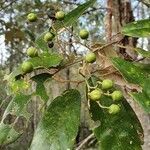Tree or shrub (2–) 4–20 (–35) m high. Bark persistent, tessellated and dark at base of large trees; otherwise smooth, dappled white and grey. Primary branches ascending, with secondary and tertiary branches on different planes. Branchlets not prominently ridged near growing point. Stipules linear to narrowly triangular, (2–) 3–14 (–18) mm long. Juvenile stem indumentum in some forms dense, rusty, straight to flexuose, patent, to 0.6 mm high; in other forms with moderately dense white crisped hairs to 0.1 mm high, and scattered brown straight or flexuose hairs to 0.4 mm high. Juvenile leaves variable, sometimes broadly elliptic, lower surface with white hairs throughout, apex obtuse, petiole very short; sometimes narrowly ovate, lower surface with abundant rusty hairs on veins, apex acute to acuminate. Adult stem indumentum sparse to dense, grey to creamy-white, crisped hairs c. 0.1 mm high, and scattered erect flexuose hairs to 0.3 mm high. Leaves 2-ranked; lamina elliptic, narrowly elliptic, narrowly ovate or lanceolate, (4–) 6.1–18.5 (–20) cm long, (1–) 1.8–6 (–8) cm wide (L/B ratio 2.2–4.6), base cuneate, occasionally obtuse, symmetrical or not, apex acute or obtuse, sometimes mucronate; upper leaf surface dark green, glossy, glabrous except when very young, when numerous white or pale brown tortuous hairs cover the surface; lower leaf surface with abundant tiny white crisped hairs in the areoles, obscuring the lamina, and scattered pale brown tortuous hairs to 0.6 mm long along the veins and veinlets; newly expanded leaves mid-brown to pale brown; petiole 0.8–2.3 cm long, hair cover 0.1–0.5 mm high. Cymes occurring in up to 7 leaf axils per branchlet, each 3.5–9 (–15) cm long, 2–10 cm wide, with > 50 flowers when flowering, none truly terminal. Pedicels 1.7–4 mm long at anthesis. Bracts ovate, c. 0.5–1.5 mm long, 0.5–1.2 mm wide. Flowers 4–6 mm across, covered in greyish to rusty crisped hairs; sepals deltate, 1.4–1.7 (–2) mm long, 1.2–1.7 mm wide at base, spreading or recurved, glabrous internally; petals white, 1.2–1.7 mm long, ± clawed; filaments 1.0–1.4 mm long; anthers 0.2–0.4 mm long, tail 0.05–0.1 mm long. Disc pentagonal to circular, grey, not papillose, surface flat or undulate, radial furrows absent or present (10); densely or sparsely hairy (erect brown or white hairs close to style) or glabrous. Style 2 (3)-fid, (0.6–) 0.8–1.2 mm long after elongation. Fruiting pedicels 1.5–5 mm long, 0.7–0.9 mm diam. Mature fruits black and somewhat glossy at maturity or occasionally with a glaucous bloom, glabrous, globose, 2 (3)-locular, 7–10 mm long, 7–11 mm diam.; calyx scar close to pedicel end, or sometimes almost halfway along; powdery mesocarp abundant. Endocarpids (when opened) 6–8.2 mm long (excluding apiculum), 6–6.5 mm wide, radius 3–5 mm; apiculum 0.5–1 mm long, terminal. Aril maroon; seeds grey, 4–5.7 (–8) mm long.
More
A tree which may or may not lose its leaves during the year. It loses its leaves in cooler climates. It grows to 12-18 m tall and spreads to 5-10 m across. It can be 30 m tall. The stem is erect. The bark is grey and smooth in young plants but cracked along its length in older plants. The branches come out in layers. Young parts of the plant are covered with rusty hairs. The leaves are dark green above and glossy. They are paler underneath. They are broadly oval, smooth and 7-15 cm long by 4-6 cm wide. The leaf stalk is 2 cm long and generally softly hairy. The flowers are cream and very small. They occur in dense clusters near the ends of branches. The flowers are about 0.5 cm across and have a scent. The fruit are dull black berries. They are 1 cm across and corky or mealy in texture. They contain 3-5 glossy brown seeds. These are 5 mm long by 4 mm wide.


